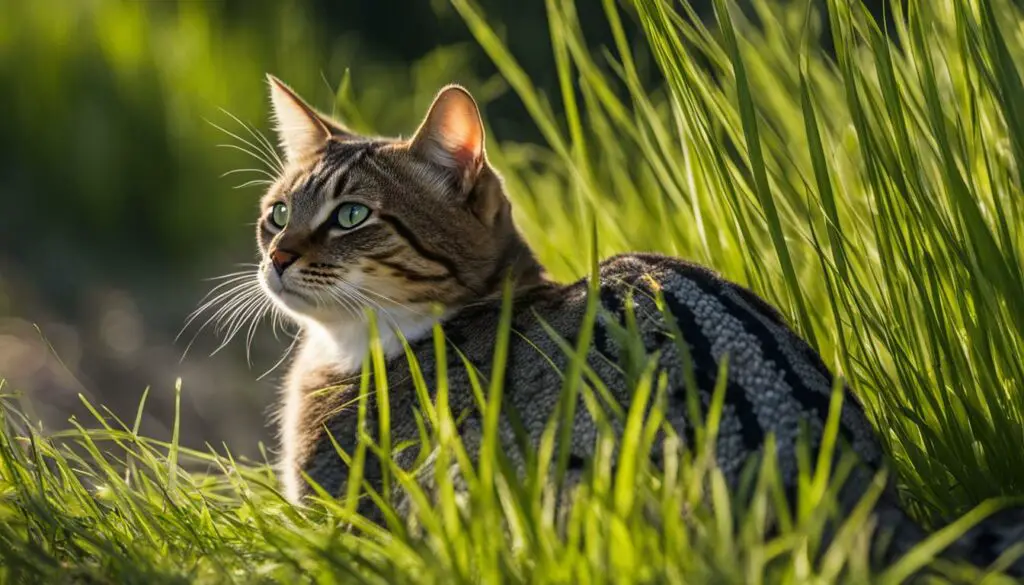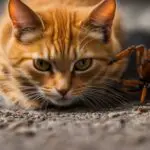I am fascinated by the complex behaviors of our feline friends, especially when it comes to their predatory instincts. One question that often piques my curiosity is whether cats can actually kill snakes. It’s a topic that sparks interest and debate among cat owners and reptile enthusiasts alike. Let’s delve into the world of cat and snake interaction to uncover the truth behind this intriguing rivalry.
Research has shown that domestic cats and feral cats have a significant impact on bird populations and reptile populations. Cats’ hunting instincts and abilities make them formidable predators, capable of exerting considerable pressure on small reptile populations, leading to a decline in their numbers. This raises the question of whether cats can also successfully take down snakes, given their inherent hunting skills and feline predator-prey relationship.
Key Takeaways
- Cats have a natural instinct for hunting and their predatory behavior can extend to snakes.
- A cat’s ability to kill a snake may depend on factors such as the size and species of the snake, the cat’s hunting experience, and the snake’s defense mechanisms.
- Venomous snakes pose a significant threat to cats, and preventive measures should be taken to keep them safe.
- If a cat encounters a snake, it is important to prioritize their safety and seek veterinary attention if necessary.
- Understanding and respecting a cat’s fear of snakes is crucial for their well-being.
The Hunting Abilities of Cats
Cats are natural hunters with instinctual behaviors that make them adept at hunting and capturing prey. This includes their ability to hunt and kill snakes. With their sharp claws, agile movements, and keen senses, cats are formidable opponents for snakes.
Cats use a combination of stalking, pouncing, and biting techniques to hunt snakes. They rely on their excellent eyesight and hearing to locate their prey and move stealthily towards it. Once they are close enough, cats will pounce on the snake, aiming to immobilize it with their claws. They then deliver a precise bite to the snake’s head or neck, incapacitating it.
However, a cat’s success in hunting snakes can depend on various factors. Cats with a strong hunting instinct and previous experience in catching prey are more likely to be successful in killing snakes. Additionally, the size and species of the snake also play a role, as cats are more likely to overpower smaller snakes.
| Factors Affecting Cat’s Ability to Kill Snakes | Details |
|---|---|
| Hunting Instinct and Experience | Cats with a strong hunting instinct and previous successful hunts are more likely to be successful in killing snakes. |
| Size and Strength | A larger and stronger cat has an advantage in overpowering a snake. |
| Snake’s Defense Mechanisms | Venomous bites or constricting abilities of snakes require cats to be cautious and strategic in their hunting approach. |
It is important to note that while cats have the ability to kill snakes, there are risks involved. Venomous snakes pose a significant threat to both cats and humans, and it is best to keep cats away from them. Additionally, snake encounters can result in injuries to the cat if the snake retaliates with a bite or constriction.
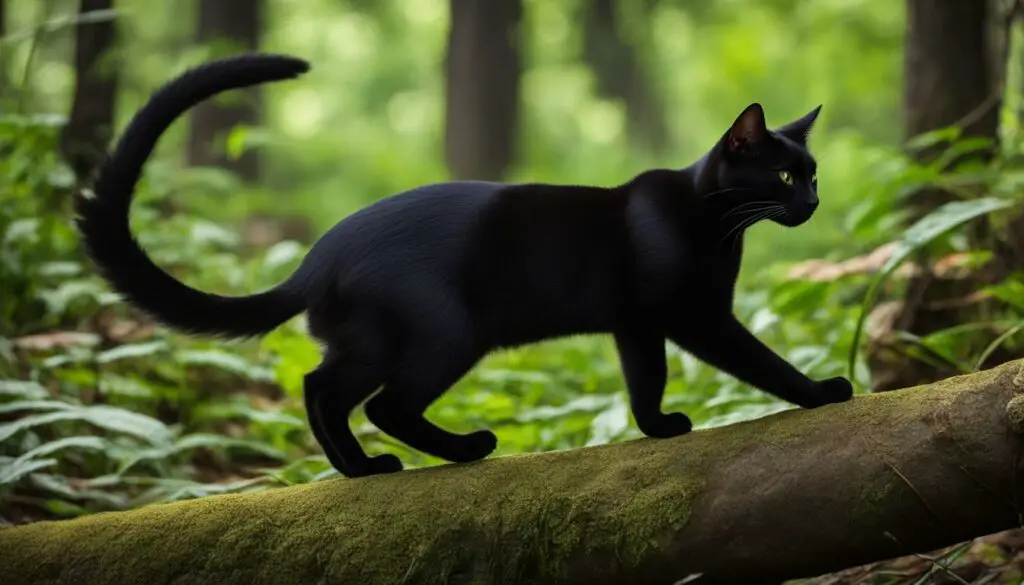
In conclusion, cats possess natural hunting abilities that make them capable of hunting and killing snakes. However, it is essential to prioritize the safety of both cats and snakes in environments where they may come into contact with each other.
Factors Affecting a Cat’s Ability to Kill Snakes
When considering a cat’s ability to kill snakes, several factors come into play. The size and species of the snake can have an impact on a cat’s success in hunting and killing it. Cats are generally more successful in overpowering and killing smaller snakes compared to larger ones. Experience and hunting skills also play a significant role. Cats that have a strong hunting instinct and previous successful hunts are more likely to be successful in their encounters with snakes.
The cat’s size and strength can give it an advantage when engaging with a snake. A larger and stronger cat may be more capable of immobilizing and overpowering the snake, increasing its chances of a successful kill. On the other hand, smaller or weaker cats may struggle to subdue larger or more aggressive snakes.
It is also essential to consider the defense mechanisms of the snake. Some snakes have venomous bites or constricting abilities, which can pose a threat to the cat. Cats instinctively recognize potential danger and may exhibit caution when approaching or engaging with snakes equipped with such defense mechanisms.
The table below summarizes the factors affecting a cat’s ability to kill snakes:
| Factors | Impact on Cat’s Ability |
|---|---|
| Size and species of the snake | Smaller snakes are easier for cats to overpower and kill compared to larger ones. |
| Experience and hunting skills | Cats with a strong hunting instinct and previous successful hunts are more likely to be successful in killing snakes. |
| Cat’s size and strength | Larger and stronger cats may have an advantage in subduing and overpowering the snake. |
| Snake’s defense mechanisms | Snakes equipped with venomous bites or constricting abilities may pose a threat to cats, requiring caution. |
The Process of Cat Hunting
When it comes to hunting snakes, cats follow a step-by-step process that showcases their innate hunting instincts and agility. From stalking to biting, each action is vital in their quest to subdue their slithery prey. Let’s explore the process in detail:
Stalking
First, cats rely on their keen senses, including their exceptional sight and hearing, to locate the snake. They move silently, carefully stalking their target, ensuring they remain undetected. This stealthy approach allows them to get closer to the snake without alarming it.
Pouncing
Once the cat is within striking distance, it pounces with speed and precision. Its agile body and sharp claws are its weapons as it lunges towards the snake, aiming to immobilize it. The element of surprise is crucial, as it gives the cat an advantage in overpowering the snake.
Biting
After successfully pouncing on the snake, the cat delivers a decisive bite to the snake’s head or neck area. This bite aims to incapacitate the snake, ensuring it is unable to defend itself or escape. By targeting these vulnerable areas, the cat maximizes its chances of a successful kill.
After the kill, cats may exhibit cautious behavior, pawing at the snake or keeping a safe distance to ensure it is dead. Their hunting instincts remain sharp even after the kill, as they understand the potential threat the snake may still pose.
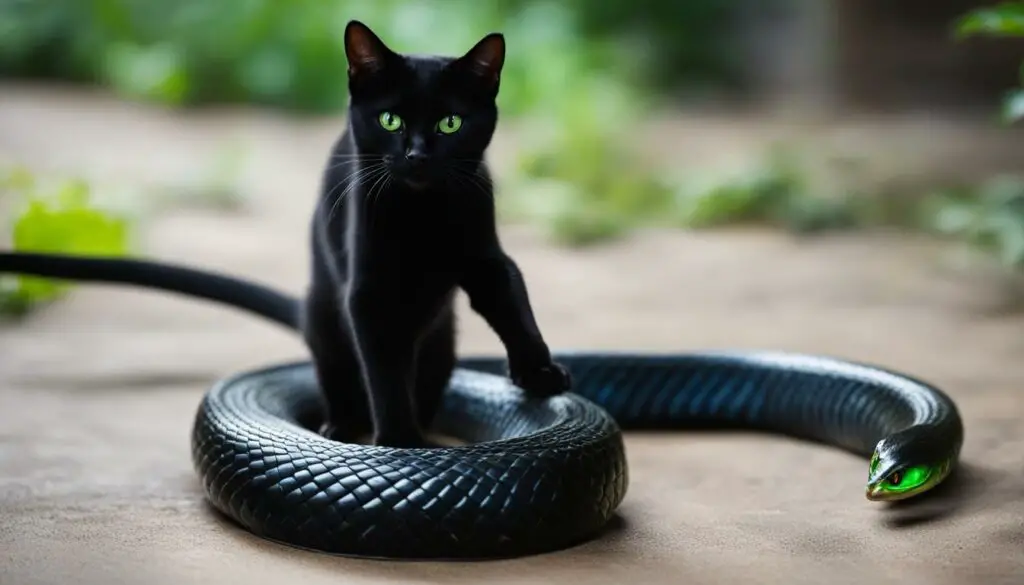
Hunting Process Summary:
- Stalking: Cats use their senses to silently approach the snake.
- Pouncing: Cats launch themselves at the snake, aiming to immobilize it.
- Biting: Cats deliver a decisive bite to the snake’s head or neck area.
This strategic approach highlights the natural hunting abilities of cats and their remarkable skill in dealing with snakes. However, it’s essential to remember that cats should be kept safe from potential risks associated with encounters with snakes.
The Risks and Dangers of Cat-Snake Interactions
When it comes to the interaction between cats and snakes, there are several risks and dangers that cat owners need to be aware of. While cats have the ability to kill snakes, it is important to consider the potential harm that both cats and snakes can inflict on each other.
Venomous snakes pose a significant threat to both cats and humans. It is crucial to keep cats away from venomous snakes to prevent potentially fatal bites. Cats may underestimate the danger posed by snakes and try to engage with them, putting themselves at risk of serious injury or even death.
“Cats may underestimate the danger posed by snakes and try to engage with them, putting themselves at risk of serious injury or even death.”
In addition to venomous bites, snakes also have other defense mechanisms, such as constricting abilities. Cats may find themselves entangled in a snake’s grip, leading to potential injury or suffocation. The size and strength of the cat can also play a role in determining the outcome of an encounter with a snake. A larger cat may have a better chance of overpowering a snake, while a smaller cat may be at a disadvantage.
| Snake Dangers | Cat Dangers |
|---|---|
| Venomous bites | Envenomation |
| Constricting abilities | Injury or suffocation |
| Defensive strikes | Bites or scratches |
To prevent cat-snake interactions and mitigate these risks, it is important to create an environment that discourages snakes from entering your property. Keeping the yard clean and free of potential snake hiding spots is a good start. Removing debris, tall grass, and piles of wood or rocks can help reduce the likelihood of snake encounters.
If you live in an area where snakes are common, consider installing snake-proof fencing around your property to provide an additional barrier of protection. Snake repellents can also be used to deter snakes from entering your yard.
By being proactive and taking preventive measures, cat owners can help ensure the safety of their feline friends and minimize the risks of cat-snake interactions.

Can Cats Be Harmed by Snake Bites?
When it comes to the interaction between cats and snakes, the question of whether cats can be harmed by snake bites is a valid concern. Cats possess natural hunting instincts that can make them vulnerable to snake encounters. Venomous snake bites, in particular, can pose a significant risk to both the feline and human populations. Understanding the potential dangers and taking appropriate preventive measures is crucial for ensuring the safety and well-being of our feline companions.
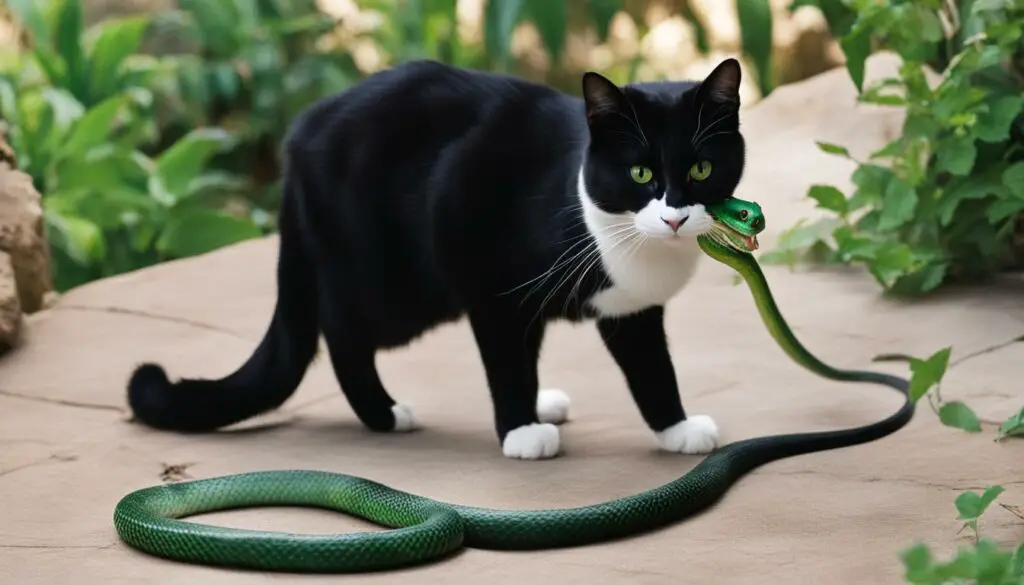
Cats’ hunting instincts drive them to engage with small moving objects, and this includes snakes. While some cats may have the experience and skills to successfully hunt and kill snakes, the risk of encountering a venomous species should not be taken lightly. Cats that are bitten by venomous snakes may experience severe symptoms, such as swelling, pain, lethargy, difficulty breathing, vomiting, and changes in behavior. Immediate veterinary attention is necessary to increase the chances of a positive outcome.
Preventing snake encounters is essential for protecting our feline friends. Keeping the yard clean and free of debris and potential snake hiding spots can reduce the likelihood of snake sightings. In areas where snakes are common, installing snake-proof fencing and using snake repellents can further minimize the risk. When cats are outdoors, close supervision is key to intervening if a snake is detected, ensuring the cat’s safety.
Protecting Cats from Snakes
When it comes to protecting cats from potential snake encounters, there are several measures that can be taken to ensure their safety. Maintaining a feline predator-prey relationship with snakes can be risky, especially in areas where venomous snakes are prevalent. Here are some ways to minimize the chances of your cat encountering a snake:
- Keep the yard clean and free of debris: Snakes are attracted to cluttered areas where they can hide. By keeping your yard clean and free of debris, you can reduce the likelihood of snakes taking up residence in your outdoor space.
- Install snake-proof fencing: If you live in an area with a high snake population, consider installing snake-proof fencing around your property. This can help keep snakes out and prevent any potential confrontations with your cat.
- Use snake repellents: There are commercially available snake repellents that can be applied to areas where snakes are likely to be found. These repellents emit odors that snakes find unpleasant, deterring them from entering your yard.
- Supervise outdoor activities: When your cat is outdoors, it’s important to keep a close eye on them. Supervising their activities can help prevent any snake encounters and allow you to intervene if necessary.
By following these protective measures, you can create a safer environment for your cat and minimize the potential risks associated with snake encounters.
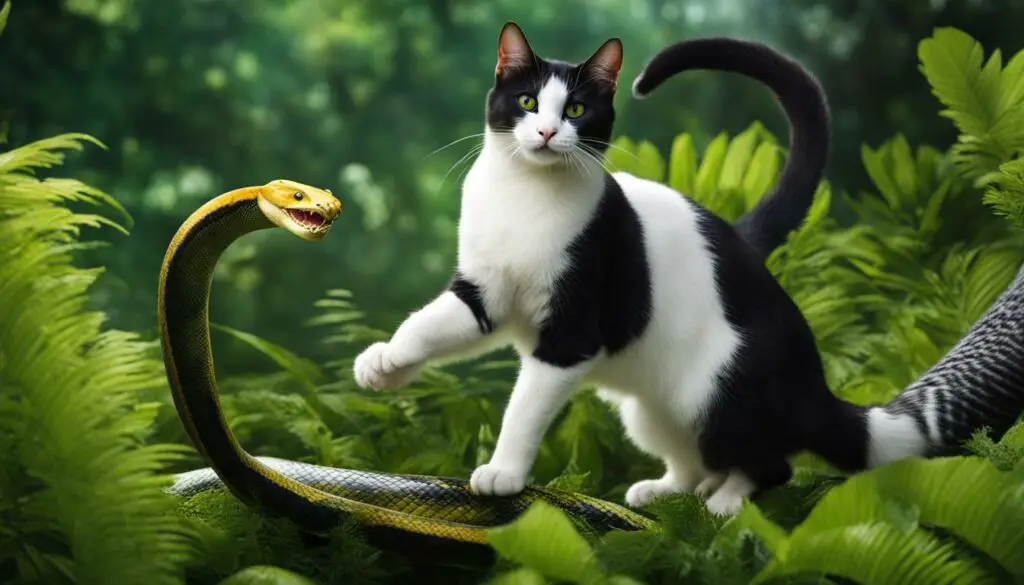
Preventive Measures for Cat Safety
It’s essential to prioritize the safety of your feline companion when it comes to snake encounters. Taking preventive measures can significantly reduce the chances of your cat coming into contact with a snake. Some additional steps you can take include:
- Keeping your cat indoors: While outdoor exploration may be appealing to cats, keeping them indoors can eliminate the risk of snake encounters altogether.
- Providing alternative forms of enrichment: Engage your cat’s hunting instincts by providing them with interactive toys and puzzle feeders. This can help satisfy their predatory needs while keeping them entertained indoors.
- Seeking veterinary attention: If you suspect your cat has been bitten by a snake or if they exhibit any unusual behavior or symptoms after a potential encounter, it’s crucial to seek immediate veterinary care. Snake bites can be life-threatening and require prompt medical attention.
| Preventive Measures | Description |
|---|---|
| Keeping your cat indoors | Eliminates the risk of snake encounters |
| Providing alternative forms of enrichment | Satisfies predatory needs and keeps cats entertained indoors |
| Seeking veterinary attention | Crucial in case of snake bites or unusual symptoms |
Cat Behavior Towards Snakes and Potential Predation
When it comes to cat behavior towards snakes, it is important to understand that cats possess natural hunting instincts that drive their interaction with these slithering reptiles. While not all cats will actively engage with snakes, some may display predatory behavior, and in certain cases, even succeed in killing them.
Observing cat behavior towards snakes can provide valuable insights into the predator-prey relationship between these two species. Cats may exhibit stalking, pouncing, and biting behaviors when encountering snakes, employing their agility and hunting prowess to try to overpower their reptilian foes. However, it is worth noting that the outcome of such encounters can vary depending on factors such as the size and species of the snake, the hunting experience of the cat, and the defensive mechanisms employed by the snake.
To illustrate the potential predation and cat behavior towards snakes, below is a table detailing different scenarios:
| Cat Behavior | Snake Size | Outcome |
|---|---|---|
| Ambivalent or fearful | Small | Cat may avoid or retreat |
| Predatory | Small | Cat may successfully kill the snake |
| Predatory | Large or venomous | Snake may overpower or injure the cat |
Note: This is a simplified representation and not an exhaustive analysis. The actual dynamics of cat behavior towards snakes can be more nuanced and dependent on various individual and environmental factors.
Encouraging Cats to Hunt Snakes
When it comes to the feline predator-prey relationship, cats have a natural hunting instinct that drives them to chase and capture small moving objects. While it may be tempting to encourage cats to hunt snakes, it is important to prioritize their safety and well-being. Snake encounters can come with risks, especially in areas with venomous snakes. Instead of encouraging cats to hunt snakes, there are alternative forms of enrichment and play that can satisfy their hunting instincts.
One way to engage cats’ hunting instincts is by providing interactive toys that simulate prey-like movements, such as feather wands or laser pointers. These toys allow cats to engage in a simulated hunting experience while keeping them safe from potential snake encounters. Additionally, puzzle toys and treat-dispensing toys can provide mental stimulation, keeping cats entertained and satisfied.
Creating an enriching indoor environment can also help satisfy cats’ hunting instincts. Setting up vertical spaces, such as cat trees or shelves, allows cats to climb and explore their environment, mimicking the experience of hunting in the wild. Providing hiding places, such as cardboard boxes or tunnels, creates opportunities for cats to engage in stalking behaviors.
In conclusion, while cats have natural hunting abilities and may be capable of killing snakes, it is important to prioritize their safety and well-being. Encouraging cats to hunt snakes can put them at risk of encountering dangerous or venomous snakes. Instead, providing alternative forms of enrichment and play can satisfy their hunting instincts while keeping them safe from harm.
Cats’ Ability to Distinguish Between Venomous and Non-Venomous Snakes
When it comes to cats’ ability to distinguish between venomous and non-venomous snakes, there is limited evidence to suggest that they have this capability. Cats primarily rely on their hunting instincts and predatory behavior when encountering snakes. Their focus is on capturing and killing the snake without necessarily discerning its level of danger.
While some cats may display caution and wariness around snakes, it is important to remember that this behavior is based on their general perception of snakes as potential prey. Cats may be more interested in hunting and catching the snake rather than assessing its venomousness.
Therefore, it is crucial for cat owners to take preventive measures and keep their feline companions away from areas where snakes are commonly found. This is especially important if the region is known to have a population of venomous snakes. By doing so, cat owners can ensure their pets’ safety and minimize the risk of snake-related incidents.
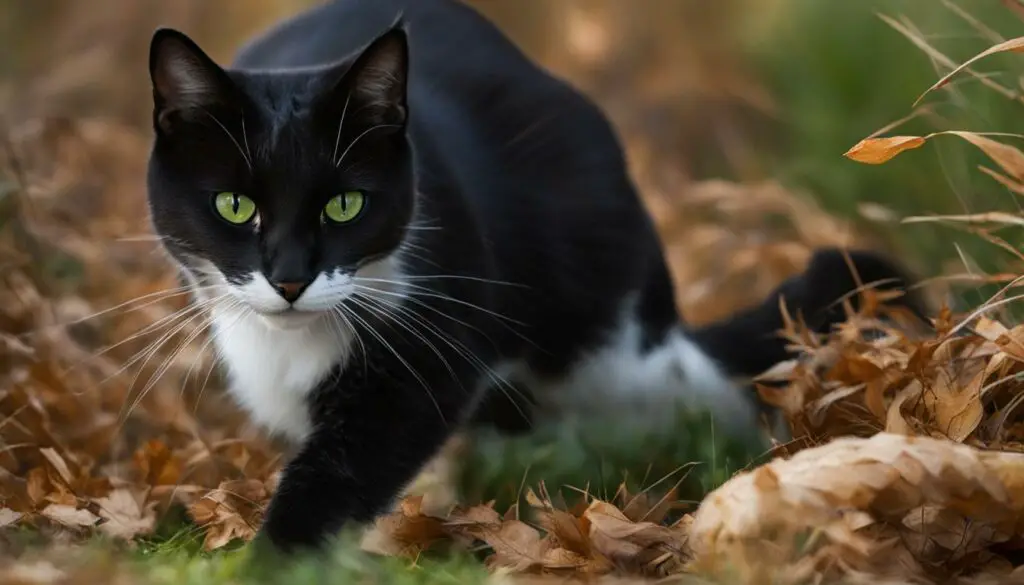
It is worth noting that even a non-venomous snake can deliver a bite that may lead to infection or cause other health issues for a cat. Therefore, it is always better to err on the side of caution and prevent any potential encounters between cats and snakes.
| Venomous Snakes | Non-Venomous Snakes |
|---|---|
| Can pose a significant threat to both cats and humans. | May still cause harm through bites or injuries. |
| Require immediate veterinary attention if bitten. | Can lead to infection or other health issues if bitten. |
| Can be fatal to cats if not treated promptly. | May not be as immediately life-threatening, but still require veterinary care. |
Cats and Snake-Controlling Breeds
When it comes to hunting and controlling snakes, certain cat breeds have a natural talent. Breeds such as Maine Coon, Siamese, Russian Blue, Bengal, and Abyssinian are known for their hunting abilities and effectiveness in dealing with snakes. These breeds possess the size, strength, agility, and hunting instincts that give them an advantage in managing snake populations.
Table: Comparison of Snake-Controlling Breeds
| Breed | Size | Strength | Agility | Hunting Instincts |
|---|---|---|---|---|
| Maine Coon | Large | Strong | High | Excellent |
| Siamese | Medium | Moderate | High | Very Good |
| Russian Blue | Medium | Moderate | High | Very Good |
| Bengal | Medium to Large | Strong | High | Excellent |
| Abyssinian | Medium | Moderate | High | Very Good |
These breeds demonstrate a higher level of aptitude in hunting and controlling snakes due to their physical attributes and innate hunting instincts. Their larger size allows them to overpower snakes more easily, while their agility enables them to swiftly chase and capture their serpentine prey. Additionally, their strong hunting instincts drive them to excel in hunting and disposing of snakes.
While these breeds have a natural inclination to control snake populations, it’s important to note that each cat is an individual, and not all cats of these breeds will exhibit the same level of proficiency in dealing with snakes. Factors such as upbringing, exposure to snakes, and individual personalities can influence a cat’s hunting abilities and effectiveness in controlling snakes.
Fear of Snakes in Cats
When it comes to encountering snakes, cats have varying reactions. Some cats are fearless and may even display curiosity or aggression towards snakes, while others may exhibit wariness or fear. Genetic factors, previous experiences, the size and appearance of the snake, and the cat’s socialization can all influence how a cat responds to snakes.
Cat behavior towards snakes can range from cautious observation to active avoidance. Cats with a strong predatory instinct may be more likely to approach and engage with snakes, while cats that have had negative experiences with snakes may show fear or anxiety. It’s important for cat owners to understand and respect their cat’s individual response to snakes in order to ensure their well-being.
While some cats may be skilled hunters and have a natural inclination to confront snakes, it’s important to prioritize their safety. Preventive measures, such as keeping cats away from areas where snakes are commonly found and maintaining a snake-free environment, are essential. Additionally, providing alternative forms of enrichment and play can help satisfy a cat’s hunting instincts without exposing them to potential dangers.
| Cat Reactions to Snakes | Description |
|---|---|
| Fearful or Avoidant | Cats may show signs of fear or anxiety when encountering snakes, avoiding them or attempting to retreat. |
| Curiosity or Aggression | Some cats may exhibit curiosity towards snakes, approaching them to investigate, or displaying aggression in an attempt to hunt or intimidate. |
| Cautionary Observation | Many cats may observe snakes from a safe distance, displaying cautious behavior and maintaining a level of vigilance. |
| Varied Responses | Each cat’s reaction to snakes can be unique, influenced by their individual personality, experiences, and genetics. |
Understanding and respecting a cat’s fear of snakes is crucial for their well-being. By taking proactive measures to create a safe environment and providing appropriate outlets for their hunting instincts, cat owners can ensure their feline companions are protected while still honoring their natural behaviors.
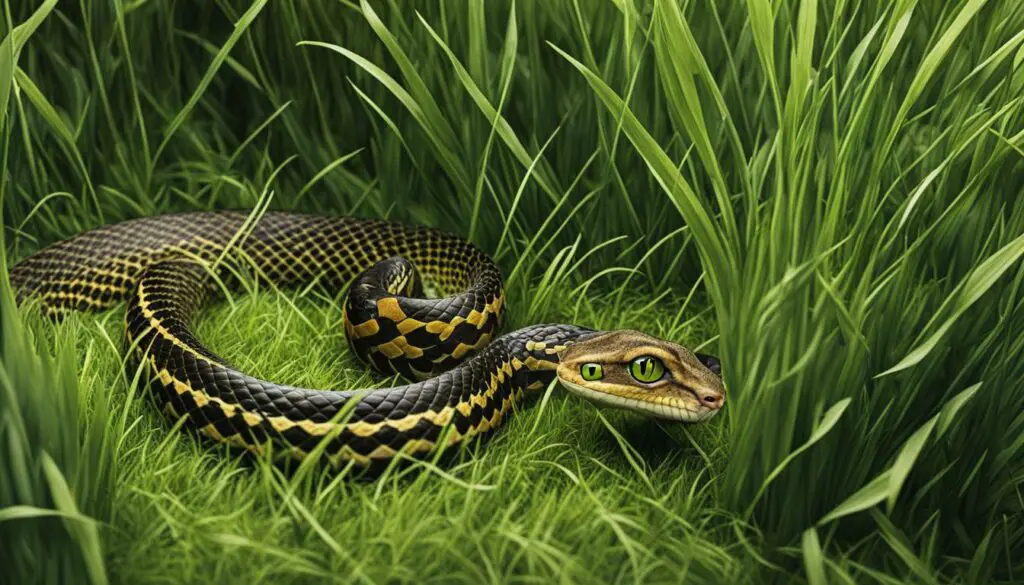
Sources:
- The Mystery of Cats‘ Fear of Snakes” – Animal Behavior Research Institute
- “Understanding Cat Behavior and Snake Encounters” – Feline Enthusiast Magazine
- “The Effect of Genetics on Cats’ Reactions to Snakes” – Journal of Feline Biology
Taking Action if Your Cat Encounters a Snake
If you find yourself in a situation where your cat encounters a snake, it is crucial to prioritize their safety. Cats are curious creatures, and their interactions with snakes can pose risks and dangers. It is important to monitor their behavior closely and intervene if necessary to prevent any harm or potential snake bites.
When your cat encounters a snake, ensure that you maintain a safe distance and keep calm. Avoid making sudden movements or loud noises that could startle the snake and potentially provoke an attack. Remember that some snakes may be venomous and pose a threat to both you and your cat, so it is essential to be cautious.
If you have access to a long object, such as a broom or a rake, you can gently guide the snake away from your cat. Do not attempt to handle or capture the snake on your own, as this can lead to injuries. Instead, focus on creating a barrier between your cat and the snake to prevent any further interactions.
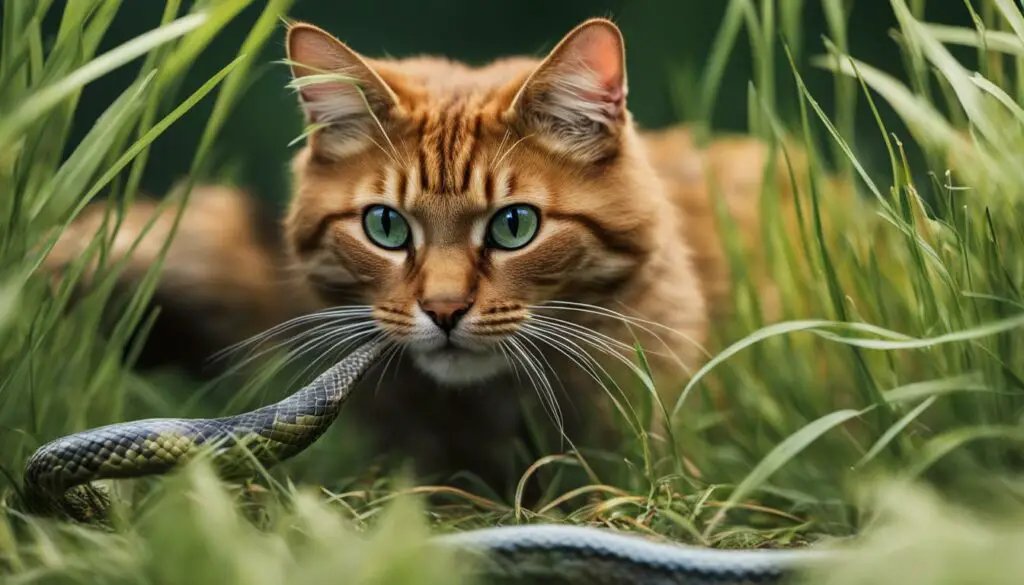
| Signs That Your Cat May Have Been Bitten by a Snake | Actions to Take |
|---|---|
| Swelling, pain, or a wound on your cat’s body | Seek immediate veterinary attention |
| Lethargy or weakness | Keep your cat calm and minimize their movements. Contact your vet for guidance. |
| Difficulty breathing | Seek immediate veterinary attention. Keep your cat calm and provide a quiet, stress-free environment. |
| Vomiting or diarrhea | Consult your veterinarian for guidance. Monitor your cat closely for any worsening symptoms. |
| Changes in behavior | Observe your cat’s behavior closely. If there are any concerning changes, contact your vet for advice. |
If you suspect that your cat has been bitten by a snake, it is crucial to seek immediate veterinary attention. Snake bites can be dangerous, especially if the snake is venomous. Remember to stay calm and keep your cat as calm as possible during transport to the veterinarian. Prompt treatment can potentially save your cat’s life.
Conclusion
After exploring the fascinating world of feline predatory behavior, it is clear that cats have the natural ability to kill snakes. Their hunting instincts, combined with their agility and predatory behavior, make them formidable opponents for these reptiles.
However, it is important to be cautious when allowing cats to interact with snakes, especially venomous ones. The risks and dangers associated with snake encounters should not be underestimated, as both cats and humans can be harmed.
In snake-prone areas, it is crucial to prioritize the safety of cats by implementing preventive measures such as keeping the yard clean and free of snake hiding spots. Monitoring cats when they are outdoors and intervening if necessary can also prevent any harm. If a cat does encounter a snake, it is important to seek veterinary attention immediately to ensure their well-being.
While cats have the ability to prey on snakes, it is best to respect and understand a cat’s fear of snakes if they exhibit it. Ensuring their safety and providing alternative forms of enrichment and play can help to keep them happy and content.
FAQ
Will a cat kill a snake?
Yes, cats have the natural ability to kill snakes due to their hunting instincts and predatory behavior.
What factors affect a cat’s ability to kill snakes?
The size and species of the snake, the cat’s hunting experience and skills, and the cat’s size and strength can all influence their ability to kill snakes.
How do cats hunt and kill snakes?
Cats use stalking, pouncing, and biting techniques to hunt and kill snakes. They immobilize the snake by pouncing on it and deliver a bite to the head or neck area to incapacitate it.
Are there risks and dangers associated with cats killing snakes?
Yes, venomous snakes can pose a significant threat to both cats and humans. Cats can also be harmed by non-venomous snakes through bites or constricting abilities.
Can cats be harmed by snake bites?
Yes, snake bites can be fatal to cats, especially if the snake is venomous. Immediate veterinary attention is crucial if you suspect your cat has been bitten by a snake.
How can I protect my cat from snakes?
Keeping your yard clean and free of snake hiding spots, installing snake-proof fencing, and supervising cats when outdoors can help prevent snake encounters and ensure their safety.
What are the signs of snake bites in cats?
Signs of snake bites in cats include swelling, pain, lethargy, difficulty breathing, vomiting, and changes in behavior. Seeking veterinary care immediately is essential.
Should I encourage my cat to hunt snakes?
It is not recommended to encourage cats to hunt snakes, especially if you live in an area with venomous snakes. Prioritizing the cat’s safety is important.
Can cats distinguish between venomous and non-venomous snakes?
Cats may not be able to distinguish between venomous and non-venomous snakes, putting them at risk of encountering a dangerous snake.
Are certain cat breeds better at hunting and killing snakes?
Breeds such as Maine Coon, Siamese, Russian Blue, Bengal, and Abyssinian have natural hunting abilities and are known to be effective at controlling snake populations.
Are all cats fearless in the face of snakes?
No, a cat’s response to snakes can be influenced by genetics, previous experiences, size and appearance of the snake, and socialization.
What should I do if my cat encounters a snake?
Prioritizing your cat’s safety, monitoring their behavior, intervening if necessary, and seeking veterinary attention in case of a snake bite are crucial steps to take.

